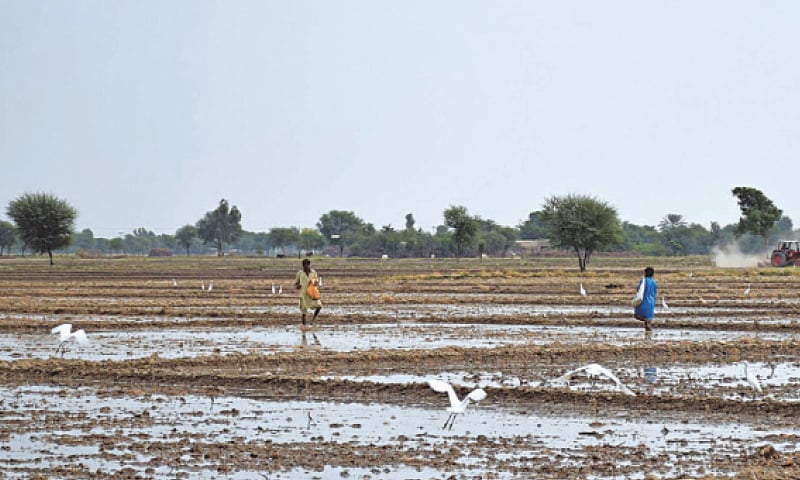WHEAT sowing is likely to face delays this year in Sindh owing to the late harvesting of the sugar cane crop.
Sugar cane crop is supposed to be harvested by October or November, but it usually faces delays because of multiple reasons. This year is no different.
Sugar cane is cultivated on around 800,000 acres, and this substantial acreage is subsequently brought under wheat sowing after sugarcane’s harvesting. It is important to note that Sindh is missing its wheat production target of four million tonnes since 2014-15.
November has already passed and the Sindh government has yet to notify a sugar cane price for the 2019-20 season and fix date for crushing by sugar factories. The provincial government is awaiting Punjab government’s decision for fixing of sugar cane prices.
Conventionally, Sindh’s sugar cane price is fixed a couple of rupees up from Punjab. That’s why Sindh awaits the fixation of price by the largest province.
However, Sugar Factories Control Act requires the Sindh government to announce the date for crushing by Nov 30.
November has already passed and the Sindh government has yet to notify a sugar cane price for the 2019-20 season and fix date for crushing by sugar factories.
Only a few sugar mills have started crushing so far and growers are selling sugar cane for Rs182 per 40kg, a rate that has been unchanged for six years. Reports indicate that some mills are paying Rs190 per 40kg owing to higher sugar prices on the retail market.
A meeting of factory owners with government officials and sugar cane growers to decide sugar cane prices ended inconclusively, which suggests that the harvesting of sugar cane and sowing of wheat will face delays.
Wheat crop is cultivated on around 2.8m acres, whereas sugar cane is usually grown on around 700,000 to 800,000 acres.
A delay in sugar cane harvesting results in the diversion of irrigation water from wheat to sugarcane, which needs a lot of water to sustain.
Farmers start sowing wheat by late October. This year, around 35pc of the sowing target was achieved till mid-November, according to official sources. The cultivation of the Rabi crop will continue till December.
By that time, the government is likely to have announced sugarcane’s official indicative rate that may accelerate pace of crop’s harvesting to enable growers bring the area under wheat sowing.
Sindh has been unable to meet its wheat production target for the last five years for one reason or the other. For instance, the target could not be met last season owing to hailstorms, which adversely affected an otherwise bumper crop, according to an agriculture official.
The government has announced a wheat support price of Rs1,350 per 40kg for this season, an increase of Rs50 as compared to the previous season.
However, growers are not content with the official rate, which they say is unjustified because of high input costs. Moreover, a rise in prices isn’t passed on to farmers during the food department’s procurement exercise.
“With present cost of inputs including urea, rising electricity tariff, seed and pesticides, the support price of wheat should have been set at Rs1,500 per 40kg,” wheat grower Syed Nadeem Shah argues.
He says the agriculture sector needs government patronisation at all levels to put an end to perennial issues such as unjustified deduction in the paddy crop, lower per-acre cotton yields, timely start of crushing and adequate wheat support price, as all these factors are interlinked.
“As if this was not enough, we are faced with a poor tomato harvest this year, which saw its prices go through the roof,” he laments. “Tomato is an essential kitchen item, and its shortage has affected all and sundry. It clearly reflects that our farm sector remains largely unregulated despite being the backbone of the economy, and producers of commodities are exploited by market forces in the absence of government oversight.”
Earlier this year, the Sindh government didn’t announce wheat procurement, leaving growers at the mercy of market players, who took full advantage of the situation.
The Sindh government decided against procuring crop at a support price of Rs1300 per 40kg in view of its carry-over stocks from last year. However, the decision backfired in the middle of the current year as the market started to face wheat shortage. This led to a surge in prices of flour which was increased from Rs40 to Rs60 per kg. The provincial food department then had to start releasing stocks from October instead of November.
But atta chakki owners like Javed Qureshi said the food department is releasing only negligible quantities of wheat and that crop was procured three years ago but lying in godowns. He said consumers mostly prefer chakki’s flour having nutrients like granulated wheat flour and super fine flour.
On growers’ part, a 40kg wheat bag was purchased from them for Rs1,050 to Rs1,150 only to be hoarded by traders. The government’s presence in the market by way of procurement does help maintain a balance to some degree. The price of flour has not been fully stabilised till last week of November despite release of wheat by the food department.
This year, Sindh’s famers have borne losses not only in wheat but in cotton and paddy crops as well. Cotton’s production has once again remained lower while paddy growers complained of an unjustified deduction in crop by factory owners at the pretext that moisture in crop is more than the permissible limit.
Looking at the present shortage of wheat in the market, wheat producers expect that government would ensure transparency in wheat procurement next year in April to make sure that support price of Rs1,350 reaches targeted and small farmers instead of middlemen, big landowners, politicians and other influential sectors.
Published in Dawn, The Business and Finance Weekly, December 2nd, 2019
















































Dear visitor, the comments section is undergoing an overhaul and will return soon.